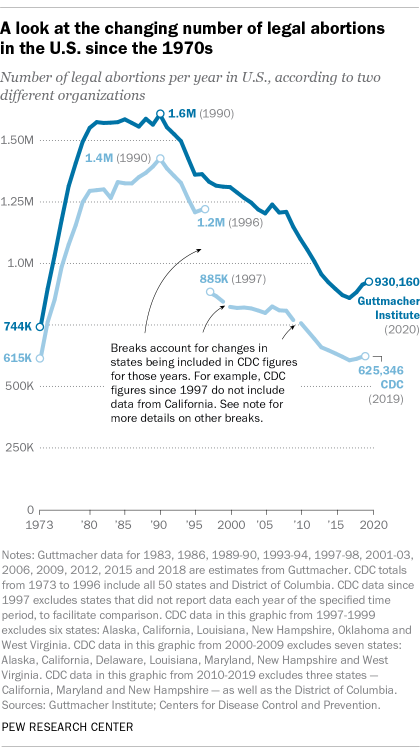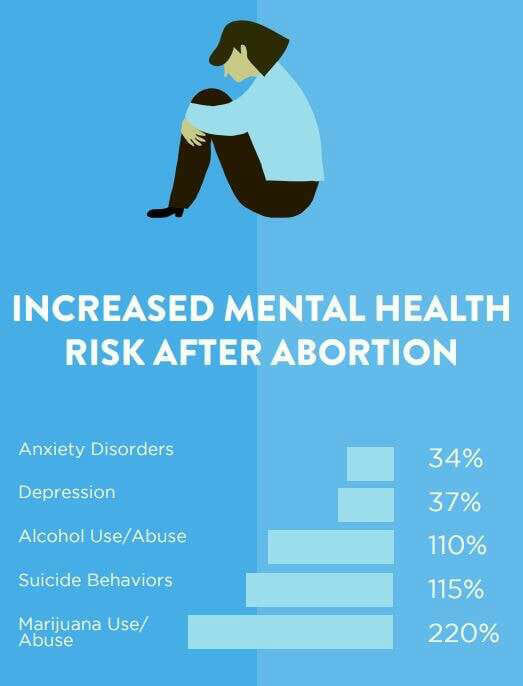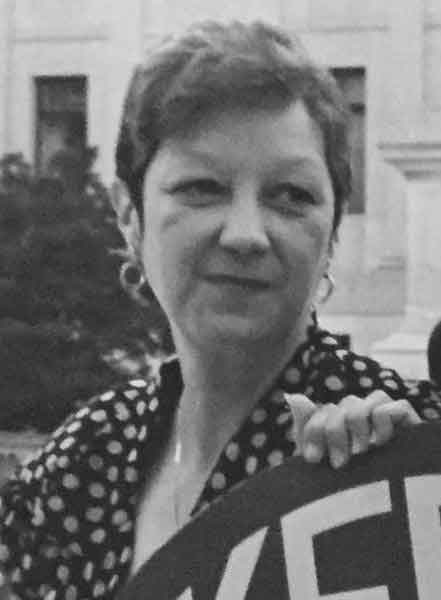Roe v. Wade
Learn
On January 22, 1973, seven men on the U.S. Supreme Court struck down more than 30 state bans on abortion, and legalized abortion through all nine months of pregnancy, for whatever reason, across the United States. Regardless of whether you know their names, these historic decisions, Roe v. Wade and Doe v. Bolton, have affected your life.
Thankfully, after nearly 50 years, the Supreme Court reversed the Roe and Doe decisions on June 24th, 2022 and returned abortion regulation to the states. Prior to their reversal, these laws were akin to abortion mandates that prevented states from banning pre-viability abortions.
America is free of the scourge of Roe v. Wade now. But what damage did it do?
Roe v. Wade Skyrocketed the Abortion Rate
There is no national abortion reporting law in America (and never has been), so only God knows the true number of babies who have been killed by abortionists. Pew Research offers a guess as to how Roe v. Wade impacted our country's abortion rate, but even they admit, "An exact answer is hard to come by. Two organizations – the Centers for Disease Control and Prevention (CDC) and the Guttmacher Institute – try to measure this, but they use different methods and publish different figures."
Yes - one of the groups "in charge" of abortion reporting is the Guttmacher Institute, the research arm of America's largest abortion vendor, Planned Parenthood. To say there is a conflict of interest there is putting it lightly. Nevertheless, Pew pulled together the following chart outlining the dramatic skyrocket in abortion count following Roe v. Wade:

Women’s Health & Safety
Consider just the impact that abortion has on a woman’s health:
- Suicide rates among post-abortive women are 6 times higher compared to those who give birth and 2 times higher compared to those have a miscarriage.
- Abortion increases the risk of placenta previa in later pregnancies by 30%. Placenta previa can lead to life-threatening hemorrhages before and after birth.
- Abortion increases the risk for breast cancer. According to the Breast Cancer Prevention Institute, from 1957-2018, 60 studies have shown a positive association of increased breast cancer risk. One of the most prominent of these was conducted by the U.S. National Cancer Institute, which found that the risk of breast cancer was 50% higher among those who had an abortion after their first pregnancy. Sources here, here, and here.
- Increased risk for pre-term delivery in future pregnancies. Pre-term delivery significantly increases the risk of infant death and disabilities such as cerebral palsy.

Read more about abortion risks here.
In reality, it was only the abortion industry that benefited from Roe v. Wade and Doe v. Bolton. For example, Planned Parenthood, America’s largest abortion chain, committed almost 345,672 abortions in 2018-2019, their largest annual total ever, and more than any other vendor. From those abortions, they made an estimated $1.6 billion dollars. And Planned Parenthood has reportedly mandated that its affiliates meet abortion quotas.
Did Roe Make Abortion Safe?
In 1972, the Centers for Disease Control (CDC) reported that 39 women died from illegal abortion and 24 died from legal abortion. While every death is a tragedy, this is a far cry from thousands of women per year. In fact, according to Mary Calderone, former director of Planned Parenthood, an estimated 90% of all illegal abortions were committed by licensed physicians in good standing. According to the CDC, “for 1972–2000, a total of 470 abortion-related deaths were reported in the 2001 abortion MMWR Surveillance Summary.” All Roe did was move the “abortion” sign from the back of the doctor’s office to the front.
The truth is that there is nothing safe about legal abortion. Even though abortion was illegal (until 2018) in Ireland, the country consistently boasts one of the lowest maternal mortality rates in the world according to WHO, UNICEF, UNFPA, World Bank Group, and the United Nations Population Division. The 1989 ban on abortion in Chile was correlated to a near complete reduction in abortion-related maternal mortality. In 2008, Chile had the second lowest maternal mortality rate in the Americas. And despite having the world’s most liberal abortion laws, the U.S. has the highest maternal death rate of any industrialized nation and lags behind 30 developed countries for mothers’ well-being.
There is nothing safe about legal abortion. Abortion will always be dangerous for women and bad for their health. Roe did nothing to change that. Legal abortion has not made abortion clean or safe. Abortionists like Kermit Gosnell and Douglas Karpen are butchering women in dirty facilities.
Women are physically & psychologically hurt (and even killed) by legal abortion. At the country’s most dangerous abortion facility, St. Louis Planned Parenthood, nearly 80 women have been sent to the ER with confirmed medical emergencies in the last 10 years alone. Read more about unsafe Planned Parenthood facilities. Learn more about other unsafe abortion facilities here.
Legal abortion enables men to cover up abuse of women and coerce them into having abortions, and abortion facilities have repeatedly been caught covering up sex trafficking and statutory rape. We need to be offering real support and options for women experiencing unplanned pregnancies – not worsening their situations.
Roe v. Wade Was Built on Lies
The pro-abortion scare tactics that “thousands of women will die when abortion is made illegal” are false. The majority of pre-Roe abortions were not committed in back-alleys and the abortion industry has admitted that it completely made up the lie that tens of thousands of women died every year from illegal abortion. When abortion is once again unthinkable and unavailable in our nation, there will not be an epidemic of women dying.

Dr. Bernard Nathanson, co-founder of NARAL, was one of the doctors fighting to legalize abortion in 1973. He himself committed over 75,000 abortions – even killing one of his own children himself. Dr. Nathanson was complicit in lying to legislators about how many women were dying in back alley abortions. He wrote,
“In NARAL, we generally emphasized the frame of the individual case, not the mass statistics, but when we spoke of the latter it was always 5,000 to 10,000 deaths a year. I confess that I knew that the figures were totally false and I suppose that others did too if they stopped to think of it. But in the ‘morality’ of our revolution, it was a useful figure, widely accepted, so why go out of our way to correct it with honest statistics?”
Later in life, Nathanson had a change of heart and renounced his pro-abortion beliefs. He wrote extensively on the error of his ways and exposed many valuable secrets about the abortion lobby’s strategies and falsehoods that led to Roe v. Wade. He is also responsible for narrating the pro-life documentary, “The Silent Scream.” He passed away in 2011.
Norma McCorvey, otherwise known as “Jane Roe” of Roe v. Wade, was another key player in the abortion ruling. The abortion lobby had been looking for someone to use as a pawn in their mission to legalize abortion. In her lawsuit, Norma claimed to have become pregnant as the result of rape and argued that she should therefore be allowed to have an abortion, despite the laws against abortion in her home state of Texas. She gave birth to the child and placed her with an adoptive family before Roe v. Wade’s passage. McCorvey remained a pro-choice activist for several years afterward.
After publicly identifying herself as Jane Roe, McCorvey became friends with advocates in the pro-life movement, including Father Frank Pavone of Priests for Life. Her book, Won By Love, recounts how the compassion pro-lifers showed to her brought her into the pro-life movement. McCorvey has admitted to the many fabrications in the Roe v. Wade case, including her claim to have been raped, and became an outspoken pro-life advocate. In 2005, she asked the United States Supreme Court to overturn Roe v. Wade on the basis of new evidence showing that abortion hurts women. McCorvey passed away in 2017.

Legal Analysis of Roe v. Wade
In Roe v. Wade, 410 U.S. 113 (1973), the U.S. Supreme Court held “unduly” restrictive state regulation of abortion to be unconstitutional, resulting in de facto legalization of abortion through all nine months of pregnancy in the entire United States. In a 7–2 vote the Supreme Court held that a set of Texas statutes criminalizing abortion in most instances violated a woman’s constitutional right of privacy, which the court found implicit in the liberty guarantee of the due process clause of the Fourteenth Amendment.
The case began in 1970 when Jane Roe (a fictional name used to protect the identity of Norma McCorvey) instituted federal action against Henry Wade, the district attorney of Dallas county, Texas, where Roe resided. The court disagreed with Roe’s assertion of an absolute right to terminate pregnancy in any way and at any time and attempted to balance a woman’s right of privacy with a state’s interest in regulating abortion.
Writing for the majority, Harry A. Blackmun noted that only a “compelling state interest” justifies regulations limiting “fundamental rights” such as privacy and that legislators must therefore draw statutes narrowly “to express only the legitimate state interests at stake.” The court then attempted to balance the state’s distinct compelling interests in the health of pregnant women and in the potential life of fetuses. It placed the point after which a state’s compelling interest in the pregnant woman’s health would allow it to regulate abortion “at approximately the end of the first trimester” of pregnancy. With regard to fetuses, the court located that point at “capability of meaningful life outside the mother’s womb,” or viability.
Repeated challenges since 1973, such as Planned Parenthood of Southeastern Pennsylvania v. Casey, 505 U.S. 833 (1992), have narrowed the scope of Roe v. Wade but have yet to overturn it. In Gonzales v. Carhart 550 U.S. 124 (2007), the Supreme Court upheld the federal Partial-Birth Abortion Ban Act of 2003 (18 U.S.C. § 1531), which prohibited a gruesome abortion procedure known as intact dilation and evacuation.
The Reversal of Roe v. Wade
On June 24th, 2022, in a 5-4 decision, the Supreme Court handed down the following: "The Constitution does not confer a right to abortion; Roe and Casey are overruled; and the authority to regulate abortion is returned to the people and their elected representatives."
The reversal came to pass thanks to a case out of Mississippi, Dobbs v. Jackson Women's Health, which sought to challenge Roe's imaginary pre-viability standard. In other words, courts throughout the years decided that states could not limit first-trimester abortions, and Mississippi said no more.
The two biggest holdings from this opinion were that Roe is reversed and “protecting the life of the unborn” is a legitimate state interest in health and safety regulations. The entire ruling is 213 pages long, but below we've pulled some of the most important quotes from it...
- “The Constitution makes no reference to abortion, and no such right is implicitly protected by any constitutional provision, including the one on which the defenders of Roe and Casey now chiefly rely—the Due Process Clause of the Fourteenth Amendment.” (Page 5)
- “It is time to heed the Constitution and return the issue of abortion to the people’s elected representatives.” (Page 6)
- “The Constitution makes no express reference to a right to obtain an abortion, and therefore those who claim that it protects such a right must show that the right is somehow implicit in the constitutional text. Roe, however, was remarkably loose in its treatment of the constitutional text. It held that the abortion right, which is not mentioned in the Constitution, is part of a right to privacy, which is also not mentioned.” (Page 14)
- “When we engage in that inquiry in the present case, the clear answer is that the Fourteenth Amendment does not protect the right to an abortion.” (Page 14)
- “The inescapable conclusion is that a right to abortion is not deeply rooted in the Nation’s history and traditions. On the contrary, an unbroken tradition of prohibiting abortion on pain of criminal punishment persisted from the earliest days of the common law until 1973.” (Page 25)
- “Not only are respondents and their amici unable to show that a constitutional right to abortion was established when the Fourteenth Amendment was adopted, but they have found no support for the existence of an abortion right that predates the latter part of the 20th century—no state constitutional provision, no statute, no judicial decision, no learned treatise.” (Page 26)
- “While individuals are certainly free to think and to say what they wish about “existence,” “meaning,” the “universe,” and “the mystery of human life,” they are not always free to act in accordance with those thoughts. License to act on the basis of such beliefs may correspond to one of the many understandings of “liberty,” but it is certainly not “ordered liberty.” (Page 30-31)
- “What sharply distinguishes the abortion right from the rights recognized in the cases on which Roe and Casey rely is something that both those decisions acknowledged: Abortion destroys what those decisions call “potential life” and what the law at issue in this case regards as the life of an “unborn human being.” See Roe, 410 U. S., at 159 (abortion is “inherently different”); Casey, 505 U. S., at 852 (abortion is “a unique act”). None of the other decisions cited by Roe and Casey involved the critical moral question posed by abortion. They are therefore inapposite. They do not support the right to obtain an abortion, and by the same token, our conclusion that the Constitution does not confer such a right does not undermine them in any way.” (Page 32)
- “In addition, when one of our constitutional decisions goes astray, the country is usually stuck with the bad decision unless we correct our own mistake. An erroneous constitutional decision can be fixed by amending the Constitution, but our Constitution is notoriously hard to amend. See Art. V; Kimble, 576 U. S., at 456. Therefore, in appropriate circumstances we must be willing to reconsider and, if necessary, overrule constitutional decisions. Some of our most important constitutional decisions have overruled prior precedents.” (Page 40)
- “In this case, five factors weigh strongly in favor of overruling Roe and Casey: the nature of their error, the quality of their reasoning, the “workability” of the rules they imposed on the country, their disruptive effect on other areas of the law, and the absence of concrete reliance.” (Page 43)
- “Roe was also egregiously wrong and deeply damaging.” (Page 44)
- “Roe was on a collision course with the Constitution from the day it was decided, Casey perpetuated its errors, and those errors do not concern some arcane corner of the law of little importance to the American people. Rather, wielding nothing but “raw judicial power,” Roe, 410 U. S., at 222 (White, J., dissenting), the Court usurped the power to address a question of profound moral and social importance that the Constitution unequivocally leaves for the people.” (Page 44)
- “Together, Roe and Casey represent an error that cannot be allowed to stand.” (Page 44)
- “Roe was incorrectly decided, but that decision was more than just wrong. It stood on exceptionally weak grounds.” (Page 45)
- “Roe found that the Constitution implicitly conferred a right to obtain an abortion, but it failed to ground its decision in text, history, or precedent.” (Page 45)
- “Roe’s reasoning quickly drew scathing scholarly criticism, even from supporters of broad access to abortion.” (Page 46)
- “But even if one takes the view that “personhood” begins when a certain attribute or combination of attributes is acquired, it is very hard to see why viability should mark the point where “personhood” begins. The most obvious problem with any such argument is that viability is heavily dependent on factors that have nothing to do with the characteristics of a fetus. One is the state of neonatal care at a particular point in time. Due to the development of new equipment and improved practices, the viability line has changed over the years.” (Pages 51-52)
- “In addition, as the Court once explained, viability is not really a hard-and-fast line.” (Page 53)
- “The viability line, which Casey termed Roe’s central rule, makes no sense, and it is telling that other countries almost uniformly eschew such a line.” (Page 53)
- “All in all, Roe’s reasoning was exceedingly weak, and academic commentators, including those who agreed with the decision as a matter of policy, were unsparing in their criticism.” (Pages 53-54)
- “The Court’s abortion cases have diluted the strict standard for facial constitutional challenges.60 They have ignored the Court’s third-party standing doctrine.61 They have disregarded standard res judicata principles.62 They have flouted the ordinary rules on the severability of unconstitutional provisions,63 as well as the rule that statutes should be read where possible to avoid unconstitutionality.64 And they have distorted First Amendment doctrines.” (Page 63)
- “Our decision returns the issue of abortion to those legislative bodies, and it allows women on both sides of the abortion issue to seek to affect the legislative process by influencing public opinion, lobbying legislators, voting, and running for office. Women are not without electoral or political power. It is noteworthy that the percentage of women who register to vote and cast ballots is consistently higher than the percentage of men who do so.” (Page 65)
- “And to ensure that our decision is not misunderstood or mischaracterized, we emphasize that our decision concerns the constitutional right to abortion and no other right. Nothing in this opinion should be understood to cast doubt on precedents that do not concern abortion. (Page 66)
- “But we cannot exceed the scope of our authority under the Constitution, and we cannot allow our decisions to be affected by any extraneous influences such as concern about the public’s reaction to our work.” (Page 67)
- “This Court cannot bring about the permanent resolution of a rancorous national controversy simply by dictating a settlement and telling the people to move on. Whatever influence the Court may have on public attitudes must stem from the strength of our opinions, not an attempt to exercise “raw judicial power.” (Pages 68-69)
- “We therefore hold that the Constitution does not confer a right to abortion. Roe and Casey must be overruled, and the authority to regulate abortion must be returned to the people and their elected representatives.” (Page 69)
- “Precedents should be respected, but sometimes the Court errs, and occasionally the Court issues an important decision that is egregiously wrong. When that happens, stare decisis is not a straitjacket.” (Page 70)
- “But we have stated unequivocally that “[n]othing in this opinion should be understood to cast doubt on precedents that do not concern abortion.” Supra, at 66. We have also explained why that is so: rights regarding contraception and same-sex relationships are inherently different from the right to abortion because the latter (as we have stressed) uniquely involves what Roe and Casey termed “potential life.” (Page 71)
